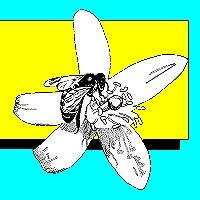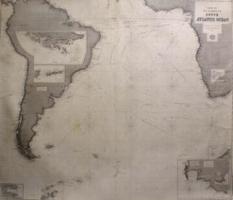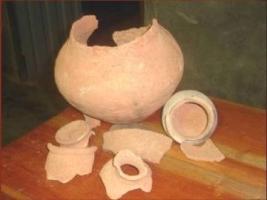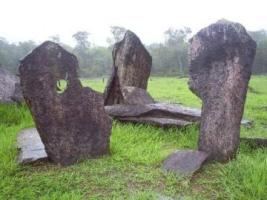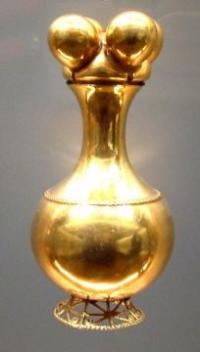APIS Volume 11, Number 10, October 1993

In this issue
Miticur (R) Withdrawn From Market
Beekeeping Database Available
National Honey Board Doings
The Great Mite Plague of 1993
MITICUR (R) WITHDRAWN FROM MARKET
It's official. Hoechst-Roussel Agri-Vet Co. has decided not to market Miticur (R) bee mite strips. Although not a surprise, this is still a disappointment to many who believed that the strips were a much needed alternative to the one chemical now registered for Varroa control, Apistan (R), and the use of menthol in tracheal mite control. This action leaves the beekeeping industry one product poorer in its continuing war against parasitic bee mites. It also punctuates the advice that whatever chemicals beekeepers do have to control diseases and pests should be used with utmost caution and care.
PANHANDLE SEMINAR A SUCCESS
Well over sixty persons attended the beekeeping seminar near Pensacola at Bear Lake Recreational Area. Malcolm "Doc" Bullard and a dedicated local crew did a bangup job organizing the event. The featured speakers were Mr. Laurence Cutts and myself, but several persons assisted with invaluable information. Especially important were contributions of Joe Robinson about local cotton nectar resources, and out-of-towner Rich Henry (all the way from the Florida keys) on producing and marketing round section honey. The food was outstanding as was the camaraderie.
This event was organized by the Escarosa Beekeepers Association as an alternative to the 4-H Camp Ocala Beekeepers Institute, cancelled in August due to low attendance. The enthusiasm of the group couldn't have been higher and the open-hive demonstrations were helped by excellent weather conditions. It was an intense two days. One was taken up with the seminar (7:00 a.m. to 7:00 p.m.). The day before, the local arrangements committee provided the opportunity for Mr. Cutts and me to appear on a talk radio show and a cable television program, sponsored by Jim Porter, President of Old South Properties, Inc., an avid beekeeper who also attended the seminar.
The success of this panhandle seminar suggests that one-day events of this sort held on a weekend (Saturday) would be a good alternative to the traditional Institute. Because the audience has changed and there are many more part-timers involved, this allows persons to attend who would not otherwise make the trip to Ocala. The necessary ingredient is a local cadre of committed individuals who would find a suitable location and make arrangements. Now that Doc Bullard and his association have some experience in this matter, I'm sure they would be willing to share it with other associations that might consider a similar venture. You can contact Mr. Bullard at 9801 Lyman Dr., Pensacola, FL 32534, ph 904/478-7690.
I have received little feedback concerning the cancellation of the August Institute. Most came from strong supporters of the event who were scheduled to attend. Although those individuals were disappointed that the Institute was cancelled, there has not been a ground swell of interest in continuing the event from others around the state. Mr. Rich Henry sent a note saying, "...I don't think the agenda or cost of the Institute is a problem...I believe 1993 was an anomaly...the Institute would benefit from a more intense marketing program." Perhaps, but the response to cancellation of the event does not support this view.
Mr. Millard Coggshall, who sold his bees twenty years ago, yet still maintains an interest in Florida beekeeping sent a picture of a panel discussion at the very first Institute (1957) showing Prof. Milledge Murphy, James Russ, himself, Arthur Brady and Vern Davis. He also has a copy of the Institute's first program in 1957 (at the time, Mr. Coggshall was president of the Florida State Beekeepers Association) and other documents relevant to Florida's beekeeping history which he would be willing to share with anyone genuinely interested in the topic. You can contact him at 1740 Virginia Drive, Clermont, FL 34711.
Mr Coggshall writes in an accompanying letter, "As you say in your September 1993 APIS, the Institute worked real good for the generation who were in beekeeping and honey production in the 1950s, 60s and mid 70s. They kept their bees in Florida all year...They really looked forward to the Institute...Since the mid 1970s, most good Florida beekeepers have been migrating to the northern 'green pastures' seeking those big crops of high priced honey. They aren't in Florida in August...Maybe the Institute will have to be done by teleconferencing or some other electronic miracle then, but I bet this, too, shall pass."
BEEKEEPING DATABASE AVAILABLE
By special arrangement with the American Association of Professional Apiculturists (AAPA), a computerized beekeeping database developed at the University of Florida is being made available. This database is featured in an upcoming issue of the apicultural journal, BeeScience. It consists of 1.4 megabytes of text, graphics and animated images and comes complete with a self-installation program. Several hundred screens of information about honey bees and beekeeping are available through easy-to-navigate menus. One animated sequence shows the decomposition of an American foulbrood infected bee pupa into a scale. The full life cycle of the honey bee is also graphically portrayed in a series complete with popup windows describing each stage. Instructions concerning the limited ability of the user to update and print screens come with the database.
The database sells for $50.00; seventy percent of the income derived is donated to the Department of Entomology and Nematology at the University of Florida for further development of computer programs involving extension entomology. The package runs on all IBM-compatible computers equipped with a hard drive, DOS 3.1 or higher, 640K memory and EGA, VGA or SVGA card and appropriate monitor. Send a check with your order to Beekeeping Database, c/o Dr. M.T. Sanford, Secretary-Treasurer AAPA, Bldg 970, Box 110620, Gainesville, FL 32611-0620. Be sure to please specify 5.25 or 3.5 inch diskettes.
NATIONAL HONEY BOARD DOINGS
The National Honey Board has recently distributed new bulk honey recipes for noncommercial foodservice operators such as schools, business and cafeterias. Recipes include honey-lemon butter for baked fish and chicken, honey tomato sauce for open- faced sandwiches, a pear and honey dessert and honey-orange peanut butter spread. The recipe cards are perforated and contain information on the back about honey's characteristics, composition, use and value-added benefits. A set of cards can be had for the asking.
A face lift has been given the Honey Board's newsletter, according to the Chairman, Mr. Binford Weaver. The concept is to make the newsletter more "readable," timely and less costly to produce. The summer, 1993 issue contains information on honey consumers and how the new nutrition labeling law will affect honey in the retail market. It features an article about the Booth family in Wyoming who are promoting their product "Cheyenne Honey," in several venues throughout the Western states. For a copy of the recipes mentioned above or to be put on the mailing list for the newsletter, contact the National Honey Board, 421 21st Ave. #203, Longmont, CO 80501-1421, ph 303/776-2337, FAX 303/776-1177.
The National Honey Board has also taken the daunting task of defining honey. It may come as a surprise that there is no officially recognized definition of this centuries-old sweet. The variability of the product works against a specific definition. Thus, the Honey Board has elected to provide an average range of values and standard deviation for fructose/glucose ratio, percent fructose and glucose, percent ash, moisture, reducing sugars and sucrose, total acidity (meq/kg) and true protein (mg/100g). This information is based on the work of Jack White, retired from the Federal Government as a chemist, but still active in honey work. Some 24 types of honey and honey products are proposed, along with a discussion of grading and official methods of analysis.
Finally, as reported in the September issue of the Iowa Honey Producers Association newsletter, the National Honey Board has helped to change the Arabian Gulf honey standards, considered by many to be non-tariff trade barriers restricting entrance of U.S. honey into the Saudi Arabian market. The new standards lower the diastase enzyme level from 8 to 3 and increase the HMF level from 40mg/kg to 80 mg/kg.
The revision was initiated following a technical seminar conducted by the National Honey Board on May 25, 1992, along with the USDA's Foreign Agricultural Service and Saudi Arabian and other officials of Gulf countries. "There was resistance and opposition to changing the standard from the other major global honey exporters to Saudi Arabia" said Bob Smith, executive director from the National Honey Board. "However, Saudi Arabia was anxious to allow quality U.S. honey in the market." This revision represents expanded opportunities for U.S. honey exporters to the Gulf states, said Smith.
THE GREAT MITE PLAGUE OF 1993
Again according to the Iowa State Honey Producers Association's September newsletter, Mr. Harry Fulton, Mississippi State Chief Apiarist, reports that Varroa mites have humbled some beekeepers and showed how little is known and how much more research is needed on the practical aspects of pest management in beekeeping operations.
Based on the unfortunate necessity of learning from experience, it appears that two treatments (not just one during the fall/winter) will be necessary to keep Varroa at bay in colonies. Beekeepers in Mississippi, Alabama and Florida have experienced a devastating loss of colonies this summer, in spite of having treated hives in the fall/winter with "Miticur Bee Mite Strips" according to label directions. In one case, hives were monitored by using the ether-roll technique and good control was noted. In all cases, the hives overwintered, built up a good population, and made a decent spring crop of honey. In July, when beekeepers went to remove the honey (after inspecting them just 2-3 weeks earlier) they found a big portion of them dead. The ground in and near the apiaries was covered with dead bees. The dead and dying hives contained a tremendous number of Varroa mites crawling on the frames. Pesticide kills were improbable since there were no crops in the area and the apiaries were isolated from mosquito spray programs. The only conclusion, based on the evidence, is that Varroa killed them. But how could that have happened? They were treated in the winter and strips were removed in February. Where did so many mites come from?
The answer is really not too hard to figure out: reinfestation! Unless your neighboring beekeepers treat, your hives will become infested; or maybe you forgot to treat a hive or two. The first thought that comes to mind is "the treatment didn't do the job!" But, where hives were monitored, it did reduce Varroa levels! This all points out that we must take Varroa seriously (as the worst pest to honey bees known in the world). Beekeepers must spend time visiting apiaries and monitoring Varroa population levels using the ether-roll or the soapy water technique. Strips must stay in the hives at least six weeks to get good control because at any one time only 10% of the mites are outside the brood cells. (Editor's note: In Iowa, if levels of Varroa exceed 10 mites in a 300-bee ether-roll test, then another treatment is necessary even if bees were treated the previous fall or spring.)
All this adds to the advice I published concerning Varroa mites as a community problem (March 1993) and as a moving target (August 1993). It cannot be said too often. Continuously monitor for Varroa or risk colony loss!
Malcolm T. Sanford
Bldg 970, Box 110620
University of Florida
Gainesville, FL 32611-0620
Phone (904) 392-1801, Ext. 143 FAX: 904-392-0190
BITNET Address: MTS@IFASGNV
INTERNET Address: MTS@GNV.IFAS.UFL.EDU








